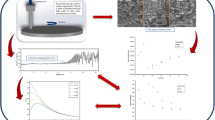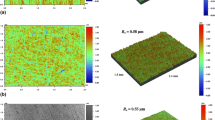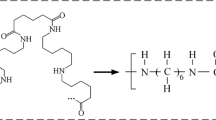Abstract
The extent of subsurface deformation below the worn surface influences friction and transfer layer formation during sliding. Thus, in this study, the extent of plastic deformation and strain localization events that occur at various depths beneath the worn surface in the subsurface zones of Cu pins slid against steel plate with various surface textures have been determined using simple metallographic techniques. Results showed that the magnitude of plastic strain gradient and the depth of highly deformed zone depend on both coefficient of friction and transfer layer formation, which in-turn depends on the surface texture of harder counterface, under both dry and lubricated conditions. In addition, itwas seen that the gradient of equivalent strain, as it approached theworn surface,was higher under dry conditions when compared to that under lubricated conditions.
Similar content being viewed by others
References
Alpas A T, Embury J D 1991 The role of subsurface deformation and strain localization on the sliding wear behaviour of laminated composites. Wear 146(2): 285–300
Alpas A T, Hu H, Zhang J 1993 Plastic deformation and damage accumulation below the worn surfaces. Wear 162–164(1): 188–195
Challen J M, Oxley P L B 1979 An explanation of the different regimes of friction and wear using asperity deformation models. Wear 53(2): 229–235
Dautzenberg J H, Zaat J H 1973 Quantitative determination of deformation by sliding wear. Wear 23(1): 9–19
Fleming J R, Suh N P 1977 Mechanics of crack propagation in delamination wear. Wear 44(1): 39–56
Gadelmawla E S, Koura M M, Maksoud T M A, Elewa I M, Soliman H H 2002 Roughness parameters. J. Mater. Process. Technol. 123(1): 133–145
Heilmann P, Rigney D A 1981 An energy-based model of friction and its application to coated systems. Wear 72: 195–217
Heilmann P, Clark W A T, Rigney D A 1983 Orientation determination of subsurface cells generated by sliding. Acta Metall. 31(8): 1293–1305
Jahanmir S 1985 The relationship of tangential stress to wear particle formation mechanisms. Wear 103(3): 233–252
Jahanmir S, Suh N P 1977a Mechanics of subsurface void nucleation in delamination wear. Wear 44(1): 17–38
Jahanmir S, Suh N P 1977b Surface topography and integrity effects on sliding wear. Wear 44(1):87–99
Jasim K M 1984 Nature of subsurface damage in Al-22 wt.% Si alloys sliding dry on steel discs at high sliding speeds. Wear 98: 183–197
Johnson K L, Jefferis J A 1963 Plastic flow and residual stresses in rolling and sliding contact. Proc. Inst. Mech. Eng. Symp. on Rolling Contact Fatigue, London pp 54–77
Kailas S V, Menezes P L 2003 Coefficient of friction and material transfer studies of an Al-Mg alloy pin on EN8 steel flat using inclined scratch. Proc. Int. Seminar on Metal Forming Process Design and Optimization, (India: Indian Institute of Science) pp 124–143
Menezes P L, Kishore, Sasidhar Y, Kailas S V 2005 Role of surface topography on friction and transfer layer formation a study using inclined scratch test. Proc. World Tribology Congress III,Washington DC, USA pp 151–152
Menezes P L, Kishore, Kailas S V 2006a Effect of surface topography on friction and transfer layer formation during sliding. Proc. of the Third Asia Int. Conf. on Tribol. (ASIATRIB 2006), Kanazawa, Japan pp 113–114
Menezes P L, Kishore, Kailas S V 2006b Studies on friction and transfer layer: Role of surface texture. Tribol. Lett. 24(3): 265–273
Menezes P L, Kishore, Kailas S V 2006c Studies on friction and transfer layer using inclined scratch. Tribol. Int. 39(2): 175–183
Moore M A, Douthwaite R M 1976 Plastic deformation below worn surfaces. Metall. Trans. 7: 1833–1839
Moore M A, Richardson R C D, Attwood D G 1972 The limiting strength of worn metal surfaces. Metall. Trans. 3: 2485–2491
Petryk H 1987 Slip line field solutions for sliding contact. Proc. Inst. Mech. Eng. Int. Conf., Tribology Friction, Lubrication and Wear 50 years on, vol II, London pp 987–994
Rice S L, Nowotny H, Wayne S F 1982 Characteristics of metallic subsurface zones in sliding and impact wear. Wear 74(1): 131–142
Rice S L, Nowotny H, Wayne S F 1989 A survey of the development of subsurface zones in the wear of materials. Key Eng. Mater. 33: 77–100
Richardson R C D 1967 The maximum hardness of strained surfaces and the abrasive wear of metals and alloys. Wear 10(5): 353–382
Rigney D A, Glaeser W A 1978 The significance of near surface microstructure in the wear process. Wear 46(1): 241–250
Rigney D A, Chen L H, Naylor M G S, Rosenfield A R 1984 Wear processes in sliding systems. Wear 100(1–3): 195–219
Rigney D A, Hirth J P 1979 Plastic deformation and sliding friction of metals. Wear 53: 345–370
Rosenfield A 1937 A shear instability model of sliding wear. Wear 116(3): 319–328
Saka N, Eleiche A M, Suh N P 1977 Wear of metals at high sliding speeds. Wear 44(1): 109–125
Solecki R (ed.) 1988 The role of subsurface zones in the wear of materials. Trans. Tech. Publ. USA
Suh N P 1973 The delamination theory of wear. Wear 25(1): 111–124
Suh N P 1986 Tribophysics. (New Jersey: Prentice hall, Inc., Englewood Cliffs)
Suh N P, Saka N 1977 The stacking fault energy and delamination wear of single-phase f.c.c. metals. Wear 44(1): 135–143
Teixeira J J P, Saka N, Suh N P 1977 Wear of copper-based solid solutions. Wear 44(1): 65–75
Tian H, Saka N 1991 Finite element analysis of an elastic-plastic two-layer half-space: sliding contact. Wear 148(2): 261–285
Tjong S C, Lau K C 2000 Tribological behaviour of SiC particle-reinforced copper matrix composites. Mater. Lett. 43(5–6): 274–280
Venkataraman B, Sundararajan G 1996 The sliding wear behaviour of Al-SiC particulate composites-II. the characterization of subsurface deformation and correlation with wear behaviour. Acta Mater. 44(2): 461–473
Wert J J, Cook W M 1988 The influence of stacking fault energy and adhesion on the wear of copper and aluminum bronze. Wear 223: 171–192
Author information
Authors and Affiliations
Corresponding author
Rights and permissions
About this article
Cite this article
Menezes, P.L., Kishore & Kailas, S.V. Subsurface deformation and the role of surface texture—A study with Cu pins and steel plates. Sadhana 33, 191–201 (2008). https://doi.org/10.1007/s12046-008-0012-7
Published:
Issue Date:
DOI: https://doi.org/10.1007/s12046-008-0012-7




